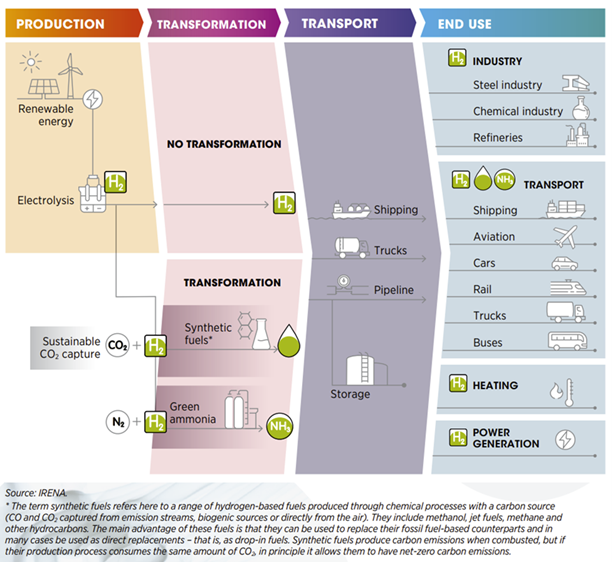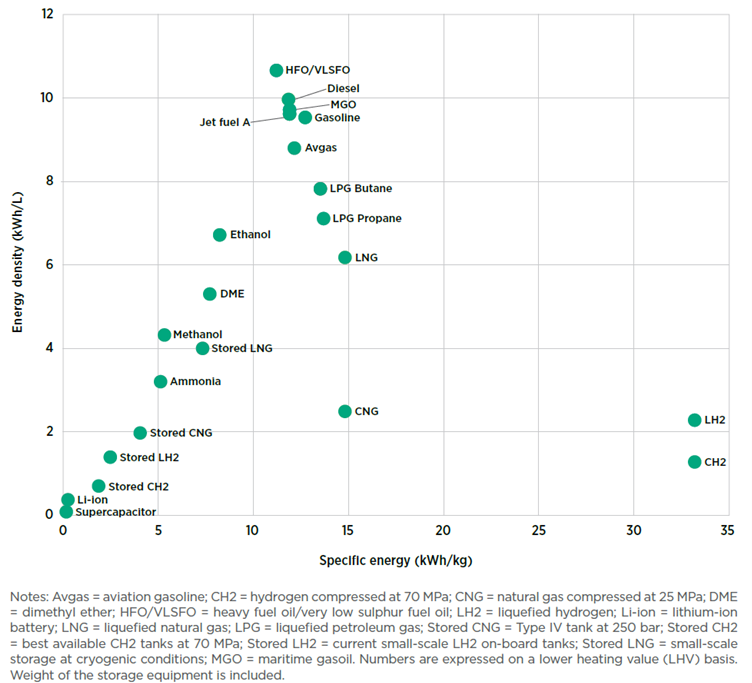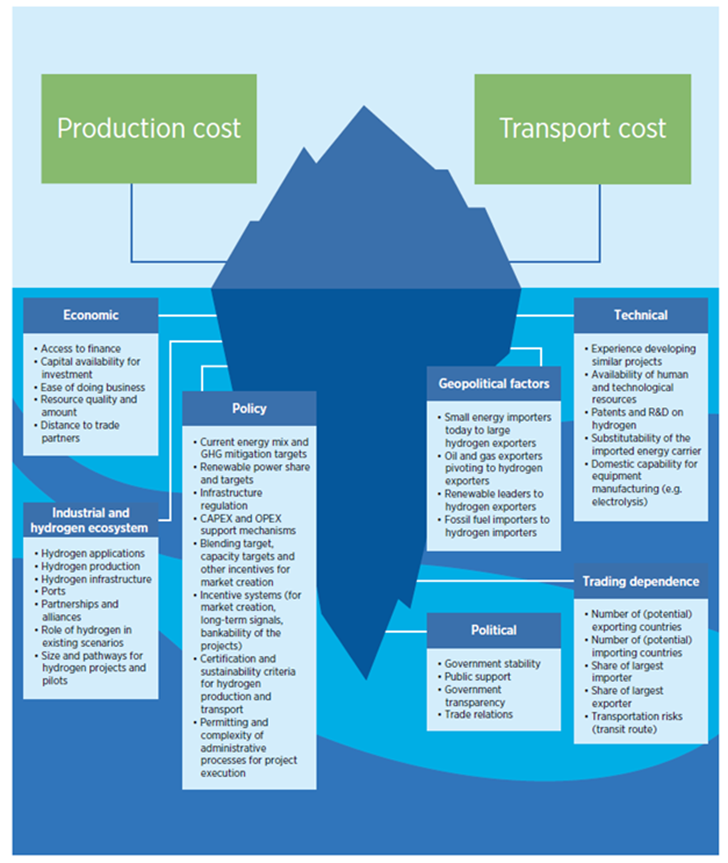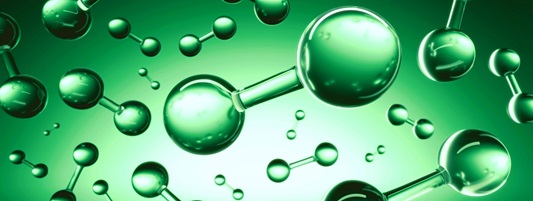Hydrogen
Overview
In recent years an increasing number of countries have committed to achieving net zero emissions. By April 2022 131 countries covering 88% of global greenhouse gas emissions had announced net zero targets. Anthropogenic emissions have already led to a global temperature increase of 1.1°C compared to pre-industrial levels. There is a broad understanding that net zero by 2050 is imperative to increase the chances of keeping this temperature increase to within 1.5°C. This renewed focus means that emissions from all the energy end uses need to be mitigated. While energy efficiency, electrification and renewables can achieve 70% of the mitigation needed, hydrogen will be needed to decarbonise end uses where other options are less mature or more costly, such as heavy industry, long-haul transport and seasonal energy storage. Considering these applications, hydrogen could contribute 10% of the mitigation needed to achieve the IRENA 1.5°C Scenario and 12% of final energy demand.
Hydrogen is produced on a commercial basis today – it is used as a feedstock in the chemical industry and in refineries, as part of a mix of gases in steel production, and in heat and power generation. Global production stands at around 75 MtH2/yr as pure hydrogen and an additional 45 MtH2/yr as part of a mix of gases. This is equivalent to 3% of global final energy demand and similar to the annual energy consumption of Germany.
Hydrogen is a versatile energy carrier (not an energy source). It can be produced from multiple feedstocks and can be used across virtually any application (see Figure 1). Renewable electricity can be converted to hydrogen via electrolysis, which can couple continuously increasing renewable energy with all the end uses that are more difficult to electrify. This coupling also allows electrolysers to provide flexibility to the grid, complementing alternatives such as batteries, demand response and vehicle-to-grid in smart electrification.

As at the end of 2021, almost 47% of the global hydrogen production is from natural gas, 27% from coal, 22% from oil (as a by-product) and only around 4% comes from electrolysis. Electricity had a global average renewable share of about 33% in 2021, which means that only about 1% of global hydrogen output is produced with renewable energy. Electrolytic hydrogen from dedicated production remained limited to demonstration projects adding up to a total capacity 0.7 GW in 2021. In contrast, the 1.5°C Scenario would need 4-5 TW by 2050, requiring a faster rate of growth than that experienced by solar photovoltaic (PV) and wind to date.
Hydrogen use as an energy carrier remains limited and is principally limited to road vehicles. By June 2021 more than 40 000 fuel cell electric vehicles were in circulation around the world, with almost 90% of those in four countries: Korea, the United States, the People’s Republic of China, and Japan. By the end of 2020 there were about 6 000 fuel cell electric buses (95% of those in China) and more than 3 100 fuel cell electric trucks. These totals are small fractions of the global vehicle fleet.
The full value of hydrogen, however, is only fully realised when it is further converted to derivatives. Hydrogen can be combined with carbon from CO2 to produce hydrocarbons and virtually any molecule. It can be used to produce ammonia, which can be used as feedstock for fertilisers (the majority of current use) or as fuel for new applications such as shipping. It can also be used to produce methanol, synthetic fuels, or even as a reducing agent to replace coal in iron production. Once it is converted to these commodities, the energy density is increased further, making long-distance transport and long-term storage cost-effective. Thus, the conversion to hydrogen derivatives effectively unlocks global renewable energy trade. For instance, liquid ammonia has almost eight times the energy density (MJ/m3) of lithium-ion batteries and more than 20 times the gravimetric energy density (MJ/kg) (see Figure 2).

The higher energy density of hydrogen-derived commodities effectively increases the distance that energy can be transported in a cost-effective way, connecting low-cost renewable energy regions with demand centres that have either limited renewable potential or costly renewable energy. Global energy trade through hydrogen derivatives would provide economic benefits as importing countries can tap into cheaper (than domestic) resources, improving the resilience of the system since there are alternative ways to satisfy final energy demand, and hence strengthening energy security.
Hydrogen trading, however, will not only be defined by the economic benefit. In the long term, when technologies have reached full maturity and are deployed at large, it is expected that importing countries will be able to count on multiple alternatives within a small cost range. Therefore, trading partners will, to a large extent, be defined by non-economic factors (see Figure 3).

Hydrogen currently has multiple challenges that may hinder the fulfilment of its potential:
- Cost. With long-term average fossil fuel prices of USD 75/bbl for oil and USD 4-6/GJ for natural gas, renewable hydrogen is two to three times more expensive to produce than the fossil references. Hydrogen pipelines can be 10-50% more expensive. Fuel cells and storage tanks for road transport are multiple times more expensive than internal combustion engines. Synthetic fuels for aviation can currently be three to six times more expensive than jet fuel from fossil oil. The cost premium for renewable pathways compared to the fossil-based options can be 50-75% for ammonia, 150% for methanol and 30-40% for steel 30-40%.
- Lack of differentiation. There is no established way to differentiate low-carbon hydrogen from fossil-based hydrogen. This means the link between (market and policy) incentives and production is missing and that there is no way for consumers to know the origin and environmental impact of the hydrogen produced. There are multiple ongoing efforts on hydrogen certification that could breach this gap.
- Lack of hydrogen market. Hydrogen is not a traded commodity today, which means there is no price index. This translates into higher costs paid by consumers since there is low price transparency and competition. There is little demand for low-carbon hydrogen and projects need to be integrated from supply to infrastructure and end use.
- Limited infrastructure. Globally, there are only about 4 500 km of hydrogen pipelines. Using renewable resources from remote locations would require additional investment in the transport infrastructure, from pipelines to conversion and liquefaction units, as well as storage, which increases the initial investment needed.
- Energy losses. Every conversion step leads to energy losses, which increase the renewable capacity needed upstream to satisfy a specific end use. Additional hydrogen use beyond the applications where it is strictly necessary will only increase the required annual pace of renewable capacity deployment which will make the decarbonisation task more challenging.
- Policy. Most of the policy efforts have so far focused on road transport, particularly for fuel cell electric vehicles and refuelling stations. With the focus on a broader set of hydrogen applications, policy attention is shifting towards comprehensive national strategies, hydrogen supply, infrastructure and uptake in industry.
Past Events
More events-
11 December 2024 Virtual
Policies and measures for green hydrogen deployment in Türkiye
-
19 November 2024 Virtual
Workshop for Green Hydrogen in the Islamic Republic of IRAN
-
22 March 2024 Virtual
9th Collaborative Framework on Green Hydrogen





